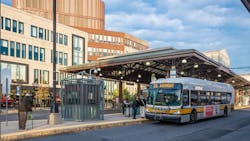MassDOT, MBTA launch new bus network map draft
The Massachusetts Bay Transportation Authority (MBTA) launched its new draft network map as part of the Bus Network Redesign.
Massachusetts Department of Transportaiton (MassDOT) Secretary and CEO Jamey Tesler and MBTA General Manager Steve Poftak today joined local community leaders, advocates and stakeholders at the State Transportation Building located at 10 Park Plaza in Boston for the official launch. Members of the public can view the draft network map online.
“We are pleased the MBTA continues to take steps to improve bus service for customers by looking at every route and getting input from riders as part of Bus Network Redesign,” said Secretary Tesler. “These are transformative changes for bus riders that include new or slightly altered bus routes to take the public where they need to go and which offer high frequency service every 15 minutes on weekdays. The Bus Network Redesign project has been a collaborative process involving the MBTA and MassDOT, which puts the customer first, and continues to build upon our efforts to invest in better, more equitable transit.”
MBTA General Manager Steve Poftak added, “We’re very excited to share these bold improvements to the MBTA bus system. Our draft network map has been redesigned to provide more equitable service that best meets the needs of where riders live, work, and travel now and in the future. We aim to reinvigorate the whole bus system through a redesign of our bus routes, 25 percent more service on weekdays and even more on weekends, and increased bus service frequency for hundreds of thousands of riders.
“But we can’t do it alone – municipal partnerships will be critical for success, and we’ll continue to shape our proposal based on input we receive from the public. We encourage everyone to engage with us at an upcoming public meeting or give us your comments on our proposal online at mbta.com/BNRD.”
More about Bus Network Redesign and the New Draft Network Map
The Greater Boston area has substantially evolved with new employment districts, shifting demographics and traffic increases while the bus network has stayed largely the same. Transit is essential to the region’s economy and bus service serves the MBTA’s most transit-dependent populations. It is essential that the MBTA’s bus network adapts to change.
An initiative of the Better Bus Project, MassDOT and the MBTA’s Bus Network Redesign project is a once-in-a-generation opportunity to make bold improvements to the MBTA’s bus network for the people that depend on it most. Bus Network Redesign completely re-imagines the bus network to reflect the travel needs of the region today, creating a better experience for current and future riders while prioritizing equity and the needs of those who depend on frequent, reliable bus service.
The plan will create more equitable service that will enable future growth. The Bus Network Redesign team has developed a simpler, easier-to-understand bus network that creates more all-day service, more service in busy neighborhoods, and new connections to more places, including to local and regional destinations. The plan includes several bus network redesign benefits, including:
- An increase in bus service by 25 percent overall with 70 percent more bus service on weekends.
- A total of 275,000 more residents would be near the newly proposed high frequency service (15 minutes or less between buses all-day, seven days a week).
- More than 100,000 Black, Indigenous, and People of Color (BIPOC) residents would gain access to high frequency service and 40,000 low-income households would gain access to high frequency service.
- More than 200,000 more residents would gain access to fast and frequent service to the Longwood Medical Area, over 180,000 to the South Boston Waterfront, over 50,000 to Back Bay and over 58,000 to Kendall Square.
More about upcoming community engagement and new network implementation timeline
The MBTA says it is excited to share the work of the Bus Network Redesign team and wants to hear what the public thinks about the draft network map. Public comment is strongly encouraged and the map will continue to be shaped following extensive public feedback. The team will hold open houses at MBTA stations and community meetings throughout the months of May, June and July 2022. Feedback can also be submitted online.
Public comments will be reviewed and incorporated into a final network that will be shared with the public in fall 2022. Implementation of this final network will take place in phases over five years starting as early as the spring of 2023 with each phase likely rolled out by geography. Implementation timing will be dependent on interdependencies of the new network, operator availability, transit priority and other operating requirements.
